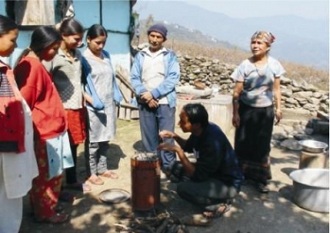Wood burning creates top cancer risk in Oregon’s air, EPA says
Pollution from burning wood in stoves, fireplaces and elsewhere is the top cancer risk in Oregon’s air, according to a U.S. Environmental Protection Agency analysis.
Burning wood and other organic material creates a greater risk than even benzene, a carcinogen belched by cars and trucks in the tens of thousands of tons each year, the analysis indicates.
By contrast, the main toxins from incomplete combustion of burning wood — a class of chemicals known as polycyclic aromatic hydrocarbons (you can smell them) — measure in the low hundreds of tons a year from Oregon’s residential sources.
“The PAHs are nasty things,” said Ted Palma, an EPA scientist who led the agency’s latest National-Scale Air Toxics Assessment, released last month.
The EPA assessment, based on 2002 emissions data, ranked Oregon’s air high in cancer risk. The state placed third highest in the nation in the number of people — about 152,000 — living in census tracts with a cancer risk of 100 in a million, the EPA’s benchmark level of concern.
But that’s largely because Oregon has done a far better job documenting the generation of wood smoke, Palma said, including surveying residents three times since 2000 to gauge actual wood stove and fireplace use.
Pollution from wood burning helped push 45 census tracts in Clackamas, Jackson, Multnomah and Washington counties above the EPA’s overall risk benchmark, accounting for a third or more of the overall air cancer risk in those counties.
Wood burning is particularly popular for home heating in southwest Oregon’s Jackson County, the state’s surveys indicate.
It’s less popular in urban counties such as Multnomah but still adds up because of the higher population, close proximity of neighbors, and heavier use of fireplaces, which spew far more pollutants than stoves.
Citing technical reasons, the EPA didn’t pin down the cancer risk of particulates from burning diesel fuel, which is dirtier than gasoline and which the agency said “is likely to be substantial.” It also didn’t gauge risks from forest fires, which dump big loads of pollutants but occur sporadically, or indoor air.
The EPA’s risk benchmark is based on 100 cancer incidents among 1 million people exposed continuously over a lifetime.
By comparison, the EPA says one out of three Americans — 330,000 in a million — will contract cancer during their lives when all causes are taken into account, including smoking and poor nutrition. Also by comparison, the national risk of contracting cancer from radon exposure, also not included in the analysis, is about 2,000 in a million.
Oregon’s Department of Environmental Quality backed successful bills in the 2009 Legislature to phase out most agricultural field burning in the Willamette Valley and require installation of less polluting wood stoves when a home is sold.
Over time, that should make a big difference, said Andy Ginsburg, DEQ’s air quality administrator. All new wood stoves require EPA certification, and certified stoves release about 70 percent less pollution than older models, the agency says, in part by burning the wood hotter and more thoroughly.
DEQ estimates that more than half the wood stoves used in about 420,000 Oregon homes are older than the EPA’s certification program.
Residents can limit open burning and cut pollution by using cleaner burning manufactured logs in fireplaces, according to the DEQ. Building small, hot fires instead of large, smoldering ones also helps. Dark smoke is a sign more pollution is being produced.
Source – http://www.oregonlive.com/environment/index.ssf/2009/07/pollution_from_burning_wood_in.html



